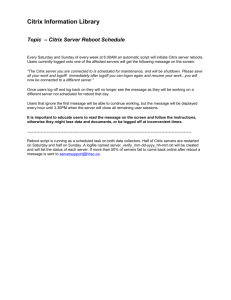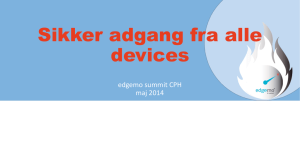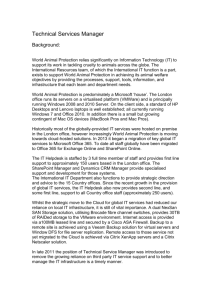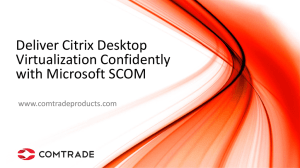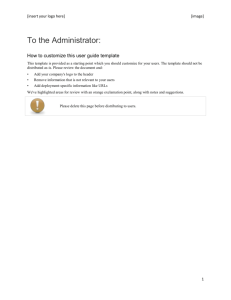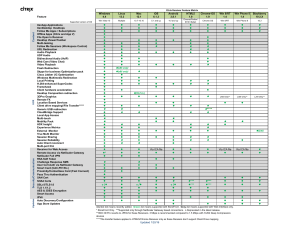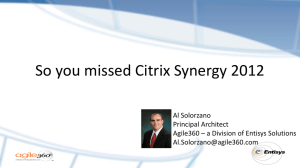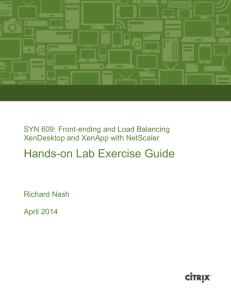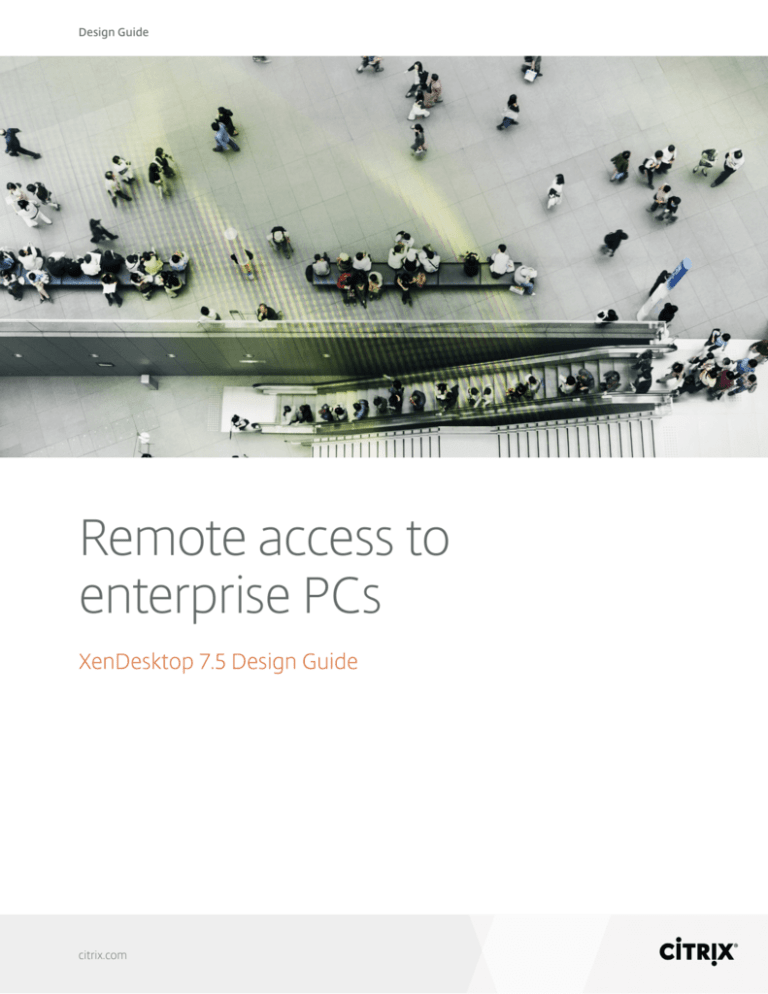
Design Guide
Remote access to
enterprise PCs
XenDesktop 7.5 Design Guide
citrix.com
Design Guide
Table of Contents
About FlexCast Services Design Guides
3
Project overview
3
Objective
3
Assumptions
4
Conceptual architecture
5
Detailed architecture
6
User layer
6
Access layer
7
Resource layer
8
Control layer
8
Hardware layer
9
Validation12
Next steps
13
citrix.com
Design Guide
Remote access to enterprise PCs
About FlexCast Services Design Guides
Citrix FlexCast Services Design Guides provide an overview of a
validated architecture based on many common scenarios. Each
design guide relies on Citrix Consulting best practices and
in-depth validation by the Citrix Solutions Lab to provide
prescriptive design guidance on the overall solution.
Each FlexCast Services Design Guide incorporates generally
available products and employs a standardized architecture,
allowing multiple design guides to be combined into a larger,
all-encompassing solution.
Project overview
Today’s workers seek improvements in their work-life balance. The implementation of a
teleworking program allows them to work from home full-time, part-time or when commuting is
less than ideal, such as during snowstorms or transit strikes.
IT must find the right tools and resources to provide remote access for teleworkers without
compromising security. Typical security concerns include protecting corporate data used by
remote workers and preventing unprotected endpoint devices from infecting the corporate
network, all without radically changing users’ work styles.
Many products can address a portion of these remote access requirements, but only Citrix®
XenDesktop® with Remote PC Access provides a comprehensive solution. XenDesktop with
Remote PC Access, available in Enterprise or Platinum editions, is simple to deploy and secure by
design. It delivers access to corporate resources without dramatically changing the user experience
or IT footprint.
Objective
The objective of the FlexCast® Services Design Guide is to construct and demonstrate an efficient
way of delivering remote access to enterprise PCs that is secured and optimized regardless of
network type, worker location and endpoint device.
This is the challenge impacting WorldWide Corporation (WWCO), a hypothetical organization that
has always issued each of its employees a physical desktop to ensure standardization and security
compliance across the enterprise.
citrix.com
3
Design Guide
Remote access to enterprise PCs
To improve employee morale, WWCO wants to enable remote access through a teleworking
initiative that ensures employees can successfully perform their jobs without compromising the
security of corporate data. In addition, the IT leadership team wants to capitalize on existing
investments in physical desktops.
To address these challenges, IT decided to implement a XenDesktop 7.5 environment utilizing
Remote PC Access to provide employees with secure remote access to their physical desktops
located in the office. To properly validate the solution, IT identified a 500-user division for the first
phase of the rollout.
WWCO business objectives
• Enable a remote access solution for a select number of employees
• Ensure that all corporate resources and data remain secure within the office when accessed remotely
• Leverage the existing physical desktop investment and security procedures
• Support remote access from personal devices, which can include mobile devices
WWCO technical objectives
• Quickly design and implement the remote access environment as the first step towards justifying
a larger deployment
• Implement an N+1 highly available solution without large cost increases
• Centrally manage and control employee access and permissions
• Support access to physical enterprise PCs from employee-owned devices with different form
factors, including tablets, phones, desktops and laptops, and different operating systems, which
include iOS, Mac, Android, Linux and Windows.
• Build a solution that scales from a few hundred users to thousands
• Utilize virtualized components, where possible, to reduce costs
• Secure all traffic crossing public network links
• Support a strong, multi-factor authentication solution
Assumptions
The following assumptions played a role in defining the overall strategy for WWCO:
• All infrastructure resources (physical and virtual servers) will be hosted from a single datacenter.
• All enterprise PCs will remain in their current locations and continue to be utilized when users are
on premise.
• High availability (HA) is required for all critical components in N+1 mode, where enough spare
capacity will be built into the system to accommodate the failure of one component without
impacting user access.
• WWCO’s existing Microsoft Active Directory and DNS/DHCP will be reused.
citrix.com
4
Design Guide
Remote access to enterprise PCs
Conceptual architecture
Figure 1, based on the overall business and technical objectives for the project as well as the
assumptions, provides a graphical overview of the solution architecture.
Figure 1: Conceptual architecture
This architecture is suitable for 500+ users requiring secure access to their physical desktop from
various mobile devices and locations.
At a high level, the following information can be ascertained from the conceptual architecture:
• The 500-user division used in the first phase of WWCO’s rollout is called Marketing. This group
will utilize personal devices to connect to their physical desktop from a remote location. Personal
devices include laptops, workstations, tablets and smartphones.
• Traffic will pass through a highly available pair of remote access appliances (Citrix NetScaler
Gateway™ appliances) where users receive their resources from the desktop and app store,
provided by StoreFront.
• The allocated resource for members of the Marketing user group is their office-based
physical desktop.
• This resource, which is a Windows XP, Windows 7 or Windows 8 physical desktop, is managed as
it was before XenDesktop 7.5 was integrated into the environment.
• The total hardware allocation requirement for the solution is two physical servers and 12 virtual
machines (VMs). Although the entire infrastructure could be delivered with fewer than 12 VMs and
two physical servers, additional VMs and physical servers are used to provide N+1 high availability.
Each layer of the architecture diagram and the relevant components are discussed in greater
detail below.
citrix.com
5
Design Guide
Remote access to enterprise PCs
Detailed architecture
The overall solution for WWCO is based on a standardized five-layer model, providing a framework
for the technical architecture. At a high level, the 5-layer model comprises:
1.User layer. Defines the unique user groups and overall endpoint requirements.
2.Access layer. Defines how user groups will gain access to their resources. Focuses on secure
access policies and desktop/application stores.
3.Resource layer. Defines the virtual resources, which could be desktops or applications, assigned
to each user group.
4.Control layer. Defines the underlying infrastructure required to support the users in accessing
their resources.
5.Hardware layer – Defines the physical implementation of the overall solution with a focus on
physical servers, storage and networking.
User layer
• The user layer focuses on the logistics of the user groups, which include client software,
recommended endpoints and office locations. This information helps define how users will gain
access to their resources, which could be desktops, applications or data.
• Citrix Receiver™ client. This client software, which runs on virtually any device and operating
platform, including Windows, Mac, Linux, iOS and Android, must be downloaded onto user
endpoints. Citrix Receiver provides the client-side functionality to secure, optimize and transport
the necessary information to/from the endpoint/host over Citrix HDX™, a set of technologies
built into a networking protocol that provides a high-definition user experience regardless of
device, network or location.
citrix.com
6
Design Guide
Remote access to enterprise PCs
• Endpoints. The physical devices could be smartphones, tablets, laptops, desktops, thin clients, etc.
Users download and install the Citrix Receiver client from their device’s app store or directly from
Citrix.com.
• Location. The Marketing user group will work from remote locations, over un-secure network
connections, requiring all authentication and session traffic to be secured.
Access layer
The access layer defines the policies used to properly authenticate users to the environment,
secure communication between the user layer and resource layer and deliver resources to the
endpoints.
The following displays access layer design decisions based on WWCO requirements.
Users connecting from…
Remote, untrusted network
Authentication point
NetScaler Gateway
Authentication policy
Multi-factor authentication (username, password and token)
Session policy
Mobile
Traditional
Session profile
ICA® Proxy
User group
Marketing
• Authentication. Allowing users to access the environment from a remote location without
authenticating would pose security risks to WWCO. When users access the environment, the
external URL will direct requests to NetScaler Gateway, which is deployed within the DMZ portion
of the network. NetScaler Gateway will accept multi-factor authentication credentials from users
and pass them to the appropriate internal resources (Active Directory domain controllers and
token authentication software such as RADIUS).
• Session policy. NetScaler Gateway can detect the type of endpoint device and deliver a specific
access experience based on device properties and policy. WWCO policies are:
- Mobile. When users connect with a mobile device, a separate policy will be applied to improve
usability of the physical Windows desktop. By using the following expression within the
NetScaler Gateway session policy configuration, this policy will only be applied to mobile
devices: “REQ.HTTP.HEADER User-Agent CONTAINS CitrixReceiver”
- Traditional. This policy will be applied to all non-mobile devices by using the following
expression within the NetScaler Gateway session policy configuration: “ns_true”
• Traditional. This policy will be applied to all non-mobile devices by using the following expression
within the NetScaler Gateway session policy configuration: “ns_true”“ns_true”
• Session profile. As the Marketing group members only require access to their respective physical
desktops, regardless of endpoint, the session profile will be configured as ICA® proxy instead of
full VPN mode. ICA proxy allows only HDX traffic to pass from the endpoint to the user’s physical
desktop through NetScaler Gateway, while full VPN mode makes the endpoint act as if it is
physically on the internal network. Using an ICA proxy session profile helps protect the
environment by allowing only session-related traffic to pass, while blocking all other traffic.
citrix.com
7
Design Guide
Remote access to enterprise PCs
In order to support the access layer design, the following components are required:
Parameter
NetScaler Gateway
Load Balancer
StoreFront
Instances
2 virtual servers
2 virtual servers.
2 virtual servers
CPU
2 vCPU
2 vCPU
2 vCPU
Memory
2 GB RAM
2 GB RAM
4 GB RAM
Disk
3.2 GB
3.2 GB
60 GB
Citrix product version
NetScaler VPX™ for vSphere
10.1 Build 126.12
NetScaler VPX Express for
vSphere 10.1 Build 126.12
StoreFront 2.5
Microsoft product version
Not applicable
Not applicable
Network ports
443
443
Redundancy
High-availability pair
High-availability pair
Windows Server 2012R2
Standard
443
Load balanced via NetScaler
Express
Resource layer
The resource layer defines the underlying image and how to deliver it to the associated VMs, which
applications to deliver and how to provide the right level of personalization and user experience
for the respective user group.
Based on WWCO’s decision to use Remote PC Access, there is no change to the Marketing users’
physical desktops. This solution simply provides a secure, remote connection to the desktop.
While the enterprise desktop will not change, WWCO still needs to design the user experience
through the use of XenDesktop policies. While authentication and security policies support IT
security goals, a satisfying experience must be provided for users. As the network link between user
and resource is dynamic and uncontrolled, policies are needed to optimize the user experience for
the WAN and mobile devices. Based on these requirements, the following policies will be used for
the environment:
Policy
Settings
Applied to…
Optimized for WAN
Based on the template “Optimized for WAN”
Any user connecting through NetScaler Gateway
Optimized for mobility
Mobile Experience
• Automatic keyboard display: Allowed
• Launch touch-optimized desktop: Allowed
• Remote the combo box: Allowed
Any user connecting through NetScaler
Gateway where Access Control = “Mobile”,
which corresponds to a NetScaler Gateway
Session Policy defined in the Access Layer.
Secure resources
Based on the template “Secure and Control”
Delivery group
Control layer
The control layer of the solution defines the virtual servers used to properly deliver the prescribed
environment detailed in the user, access, and resource layers of the solution, including required
services, virtual server specifications and redundancy options.
The decisions for the Operators group are met by correctly incorporating and sizing the control
layer components, which include delivery and infrastructure controllers.
citrix.com
8
Design Guide
Remote access to enterprise PCs
Delivery controllers
The delivery controllers manage and maintain the virtualized resources for the environment. To
support the resource layer design, the following components are required:
Parameter
Delivery Controller
Instances
2 virtual servers
CPU
2 vCPU
Memory
4 GB RAM
Disk
60 GB
Citrix product version
XenDesktop 7.5
Microsoft product version
Windows Server 2012R2 Standard
Network ports
80, 443
Redundancy
Load balanced via NetScaler Express
A single delivery controller can easily support the load of 500 users. However, for N+1 fault
tolerance, a second virtual server will provide redundancy in case one fails.
Infrastructure controllers
A fully functioning virtual desktop environment requires a set of standard infrastructure components:
Parameter
SQL Server
License Server
Instances
3 virtual servers
1 virtual servers
CPU
2 vCPU
2 vCPU
Memory
4 GB RAM
4 GB RAM
Disk
60 GB
60 GB
Citrix product version(s)
Not Applicable
Citrix License Server 11.12
Microsoft product version
Windows Server 2012R2 Standard
SQL Server 2012 Standard (x2)
SQL Server 2012 Express (x1)
Windows Server 2012R2 Standard
Network ports
1433
27000, 7279, 8082
Redundancy
SQL Mirroring with Witness
None due to 30 day grace period
To provide fault tolerance, the following options were used:
• The XenDesktop database was deployed on an HA pair of Microsoft SQL Server 2012 servers
utilizing mirroring across two virtual servers. A third virtual server running Microsoft SQL Server 2012
Express was used as a witness.
• Once active, a XenDesktop environment can continue to function for 30 days without connectivity
to the Citrix License Server. Due to the integrated grace period, no additional redundancy is required.
Hardware layer
The hardware layer is the physical implementation of the solution. It includes server, networking
and storage configurations needed to successfully deploy the solution.
citrix.com
9
Design Guide
Remote access to enterprise PCs
Server
Following is the physical server implementation for the WWCO solution:
Component
Description
Quantity
Total
Server model
HP DL380P G8
2
2 servers
Processor(s)
Intel Xeon E5-2690 @2.9GHz
4
2 processors per server (16
cores)
Memory
8GB DDR3-1333
8
32 GB per server
Disk(s)
300GB SAS @ 15,000RPM
8
1.2 TB
Microsoft product version
Windows Server 2012R2 Datacenter
2
1 per server
To provide fault tolerance for the solution, the virtual servers will be distributed so redundant
components are not hosted from the same physical server. The virtual server allocation is depicted
in Figure 3.
Server 2
NetScaler Gateway VPX
StoreFront
NetScaler VPX Express
XD Delivery Controller
SQL Server 2012 (Std)
SQL Server 2012 (Exp)
NetScaler Gateway VPX
StoreFront
NetScaler VPX Express
Citrix Licensing
XD Delivery Controller
SQL Server 2012 (Std)
Server 1
Legend
Access Layer
Control Layer
Hardware Layer
Figure 3: Virtual machine server allocation
Note: The SQL Server witness should be on a different server than the SQL Server principal.
Note: The resource load on the physical hardware for the access and control layer components is
minimal.
Note: Although this environment was designed for 500 users, it can scale significantly higher
without adding extra hardware.
Storage
The storage architecture for the solution is based on the use of inexpensive local storage. To
ensure the solution is highly available, the storage architecture must be able to overcome the
potential failure of a single drive.
citrix.com
10
Design Guide
Remote access to enterprise PCs
Parameter
Control Layer
Drive count
4
Drive speed
15,000 RPM
RAID
RAID 10
Even though the control layer servers generate IO activity, this activity is minimal. The main storage
requirement for the control layer servers is hard disk space, as defined in the control layer section.
RAID 10 is recommended because if future expansion of the solution includes hosted virtual
desktop models, the servers will not require reconfiguration.
Networking
Integrating the solution into the network requires proper configuration to have the right
components communicate with each other. This is especially important for NetScaler Gateway,
which resides in the DMZ. The network is configured based on each physical server’s having four
network ports:
NIC instance
Function
Speed
VLAN ID
1
Management VLAN
1 Gbps
1
2
Virtual machine VLAN
1 Gbps
2
3
DMZ VLAN
1 Gbps
3
4
Disabled
The three VLANs are divided among the physical servers, NetScaler Gateway and remaining virtual
servers as shown in Figure 4.
Server 1
Server 2
NetScaler Gateway VPX
StoreFront
NetScaler VPX Express
Citrix Licensing
XD Delivery Controller
SQL Server 2012 (Std)
NetScaler Gateway VPX
StoreFront
NetScaler VPX Express
XD Delivery Controller
SQL Server 2012 (Std)
Systems Center VMM
Management VLAN
DMZ VLAN
Virtual Machine VLAN
Legend
Access Layer
Control Layer
Hardware Layer
Figure 4: Networking architecture
citrix.com
11
Design Guide
Remote access to enterprise PCs
As depicted in the diagram, the VLAN is configured as follows:
• NetScaler Gateway is configured to use the DMZ VLAN. This VLAN does not connect with any
other internal networks, which helps keep the DMZ and internal traffic separated.
• The management VLAN is only connected to the physical hosts and not the VMs. This VLAN is for
management calls to/from the physical server’s hypervisor.
• The VM VLAN, meant for all non-DMZ VMs, allows them to connect to the internal network. The
VM VLAN must be able to communicate with each user’s enterprise desktop (default port: 80).
Validation
The defined solution was deployed and validated by the Citrix Solutions Lab. Here are the key
findings from the validation:
• The control layer components of SQL Server, StoreFront and delivery controllers consumed less
than 20 percent of CPU at maximum.
• NetScaler Gateway CPU, memory and network utilization was under 10 percent for the 500-user load.
• Based on the overall solution, a 1 Gbps switch would provide sufficient network capacity.
• Users were able to effectively work on their traditional, physical desktop from a remote location.
Figure 5 provides a graphical representation of the utilization of the control layer components as
the user load increased.
Figure 5: Processor Utilization for Control Layer Components
citrix.com
12
Design Guide
Remote access to enterprise PCs
Although this solution was designed to support 500 Remote PC Access users, it can scale significantly
higher without additional hardware. Next steps
When unforeseen events occur, making it difficult to commute to the office, workers may put their
lives in danger because deadlines do not change and the job must get done. For many, an
acceptable work-life balance is one of the most important aspects in ongoing career satisfaction.
XenDesktop 7.5 with Remote PC Access provides organizations with the ability to successfully
implement a teleworking program without the complexity and risks typically associated with
traditional remote access solutions.
Remote PC Access
• Eliminates the need for VPN tunnels, which often limit the types of endpoints that can be
supported
• Utilizes Citrix HDX to provide a “in-the-office” experience even though the user’s enterprise
desktop is far away
• Protects the corporate environment from exposure to the user’s environment by transmitting
only screen, keyboard and mouse data and blocking everything else
To help you learn more about the potential benefits that XenDesktop 7.5 can provide, Citrix has
prepared the following resources:
• XenDesktop 7.5 Blueprint: A layered solution for all successful designs and deployments,
focusing on the common technology framework and core decisions
• Getting Started Guide: Prescriptive guide for deploying the solution to five or 10 users quickly
and easily in a non-production environment
• FlexCast Services Design Guides: Recommended designs, with hardware layer planning numbers,
for commonly used implementations, which can be combined to form a complete solution
Corporate Headquarters
Fort Lauderdale, FL, USA
India Development Center
Bangalore, India
Latin America Headquarters
Coral Gables, FL, USA
Silicon Valley Headquarters
Santa Clara, CA, USA
Online Division Headquarters
Santa Barbara, CA, USA
UK Development Center
Chalfont, United Kingdom
EMEA Headquarters
Schaffhausen, Switzerland
Pacific Headquarters
Hong Kong, China
About Citrix
Citrix (NASDAQ:CTXS) is a leader in mobile workspaces, providing virtualization, mobility management, networking and cloud services to
enable new ways to work better. Citrix solutions power business mobility through secure, personal workspaces that provide people with
instant access to apps, desktops, data and communications on any device, over any network and cloud. This year Citrix is celebrating 25
years of innovation, making IT simpler and people more productive. With annual revenue in 2013 of $2.9 billion, Citrix solutions are in use at
more than 330,000 organizations and by over 100 million users globally. Learn more at www.citrix.com.
Copyright © 2014 Citrix Systems, Inc. All rights reserved. Citrix, XenDesktop, FlexCast, Citrix Receiver, HDX, NetScaler Gateway, ICA,
NetScaler VPX and NetScaler are trademarks of Citrix Systems, Inc. and/or one of its subsidiaries, and may be registered in the U.S. and other
countries. Other product and company names mentioned herein may be trademarks of their respective companies.
0714/PDF
citrix.com
13

